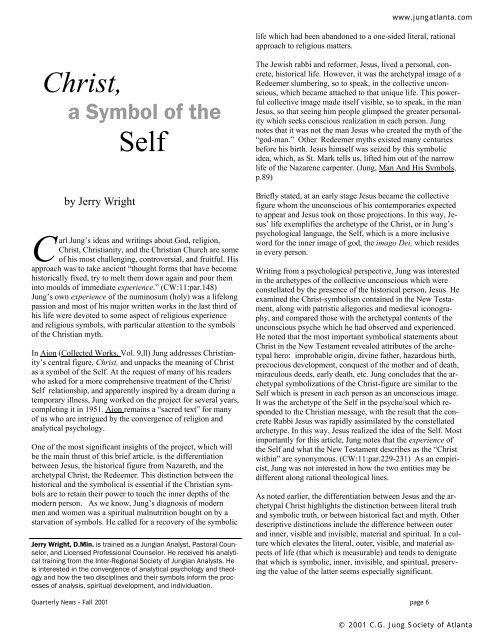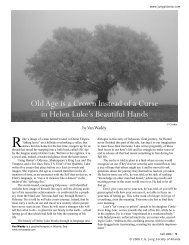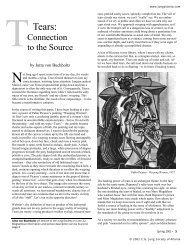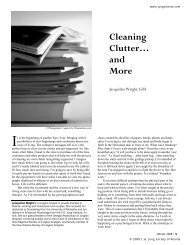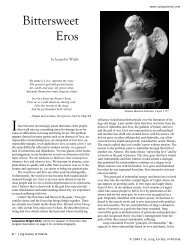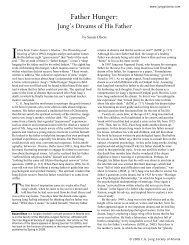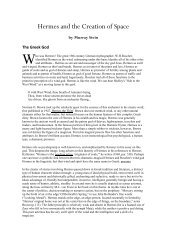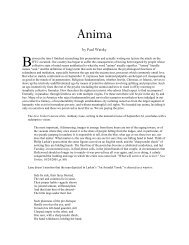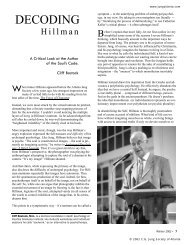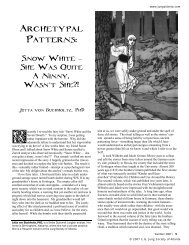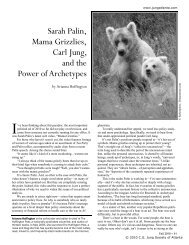Christ, a Symbol of the Self - C.G. Jung Society of Atlanta
Christ, a Symbol of the Self - C.G. Jung Society of Atlanta
Christ, a Symbol of the Self - C.G. Jung Society of Atlanta
You also want an ePaper? Increase the reach of your titles
YUMPU automatically turns print PDFs into web optimized ePapers that Google loves.
<strong>Christ</strong>,<br />
a <strong>Symbol</strong> <strong>of</strong> <strong>the</strong><br />
<strong>Self</strong><br />
by Jerry Wright<br />
C<br />
arl <strong>Jung</strong>’s ideas and writings about God, religion,<br />
<strong>Christ</strong>, <strong>Christ</strong>ianity, and <strong>the</strong> <strong>Christ</strong>ian Church are some<br />
<strong>of</strong> his most challenging, controversial, and fruitful. His<br />
approach was to take ancient “thought forms that have become<br />
historically fixed, try to melt <strong>the</strong>m down again and pour <strong>the</strong>m<br />
into moulds <strong>of</strong> immediate experience.” (CW:11:par.148)<br />
<strong>Jung</strong>’s own experience <strong>of</strong> <strong>the</strong> numinosum (holy) was a lifelong<br />
passion and most <strong>of</strong> his major written works in <strong>the</strong> last third <strong>of</strong><br />
his life were devoted to some aspect <strong>of</strong> religious experience<br />
and religious symbols, with particular attention to <strong>the</strong> symbols<br />
<strong>of</strong> <strong>the</strong> <strong>Christ</strong>ian myth.<br />
In Aion (Collected Works, Vol. 9,ll) <strong>Jung</strong> addresses <strong>Christ</strong>ianity’s<br />
central figure, <strong>Christ</strong>, and unpacks <strong>the</strong> meaning <strong>of</strong> <strong>Christ</strong><br />
as a symbol <strong>of</strong> <strong>the</strong> <strong>Self</strong>. At <strong>the</strong> request <strong>of</strong> many <strong>of</strong> his readers<br />
who asked for a more comprehensive treatment <strong>of</strong> <strong>the</strong> <strong>Christ</strong>/<br />
<strong>Self</strong> relationship, and apparently inspired by a dream during a<br />
temporary illness, <strong>Jung</strong> worked on <strong>the</strong> project for several years,<br />
completing it in 1951. Aion remains a “sacred text” for many<br />
<strong>of</strong> us who are intrigued by <strong>the</strong> convergence <strong>of</strong> religion and<br />
analytical psychology.<br />
One <strong>of</strong> <strong>the</strong> most significant insights <strong>of</strong> <strong>the</strong> project, which will<br />
be <strong>the</strong> main thrust <strong>of</strong> this brief article, is <strong>the</strong> differentiation<br />
between Jesus, <strong>the</strong> historical figure from Nazareth, and <strong>the</strong><br />
archetypal <strong>Christ</strong>, <strong>the</strong> Redeemer. This distinction between <strong>the</strong><br />
historical and <strong>the</strong> symbolical is essential if <strong>the</strong> <strong>Christ</strong>ian symbols<br />
are to retain <strong>the</strong>ir power to touch <strong>the</strong> inner depths <strong>of</strong> <strong>the</strong><br />
modern person. As we know, <strong>Jung</strong>’s diagnosis <strong>of</strong> modern<br />
men and women was a spiritual malnutrition bought on by a<br />
starvation <strong>of</strong> symbols. He called for a recovery <strong>of</strong> <strong>the</strong> symbolic<br />
Jerry Wright, D.Min. is trained as a <strong>Jung</strong>ian Analyst, Pastoral Counselor,<br />
and Licensed Pr<strong>of</strong>essional Counselor. He received his analytical<br />
training from <strong>the</strong> Inter-Regional <strong>Society</strong> <strong>of</strong> <strong>Jung</strong>ian Analysts. He<br />
is interested in <strong>the</strong> convergence <strong>of</strong> analytical psychology and <strong>the</strong>ology<br />
and how <strong>the</strong> two disciplines and <strong>the</strong>ir symbols inform <strong>the</strong> processes<br />
<strong>of</strong> analysis, spiritual development, and individuation.<br />
life which had been abandoned to a one-sided literal, rational<br />
approach to religious matters.<br />
The Jewish rabbi and reformer, Jesus, lived a personal, concrete,<br />
historical life. However, it was <strong>the</strong> archetypal image <strong>of</strong> a<br />
Redeemer slumbering, so to speak, in <strong>the</strong> collective unconscious,<br />
which became attached to that unique life. This powerful<br />
collective image made itself visible, so to speak, in <strong>the</strong> man<br />
Jesus, so that seeing him people glimpsed <strong>the</strong> greater personality<br />
which seeks conscious realization in each person. <strong>Jung</strong><br />
notes that it was not <strong>the</strong> man Jesus who created <strong>the</strong> myth <strong>of</strong> <strong>the</strong><br />
“god-man.” O<strong>the</strong>r Redeemer myths existed many centuries<br />
before his birth. Jesus himself was seized by this symbolic<br />
idea, which, as St. Mark tells us, lifted him out <strong>of</strong> <strong>the</strong> narrow<br />
life <strong>of</strong> <strong>the</strong> Nazarene carpenter. (<strong>Jung</strong>, Man And His <strong>Symbol</strong>s,<br />
p.89)<br />
Briefly stated, at an early stage Jesus became <strong>the</strong> collective<br />
figure whom <strong>the</strong> unconscious <strong>of</strong> his contemporaries expected<br />
to appear and Jesus took on those projections. In this way, Jesus’<br />
life exemplifies <strong>the</strong> archetype <strong>of</strong> <strong>the</strong> <strong>Christ</strong>, or in <strong>Jung</strong>’s<br />
psychological language, <strong>the</strong> <strong>Self</strong>, which is a more inclusive<br />
word for <strong>the</strong> inner image <strong>of</strong> god, <strong>the</strong> imago Dei, which resides<br />
in every person.<br />
Writing from a psychological perspective, <strong>Jung</strong> was interested<br />
in <strong>the</strong> archetypes <strong>of</strong> <strong>the</strong> collective unconscious which were<br />
constellated by <strong>the</strong> presence <strong>of</strong> <strong>the</strong> historical person, Jesus. He<br />
examined <strong>the</strong> <strong>Christ</strong>-symbolism contained in <strong>the</strong> New Testament,<br />
along with patristic allegories and medieval iconography,<br />
and compared those with <strong>the</strong> archetypal contents <strong>of</strong> <strong>the</strong><br />
unconscious psyche which he had observed and experienced.<br />
He noted that <strong>the</strong> most important symbolical statements about<br />
<strong>Christ</strong> in <strong>the</strong> New Testament revealed attributes <strong>of</strong> <strong>the</strong> archetypal<br />
hero: improbable origin, divine fa<strong>the</strong>r, hazardous birth,<br />
precocious development, conquest <strong>of</strong> <strong>the</strong> mo<strong>the</strong>r and <strong>of</strong> death,<br />
miraculous deeds, early death, etc. <strong>Jung</strong> concludes that <strong>the</strong> archetypal<br />
symbolizations <strong>of</strong> <strong>the</strong> <strong>Christ</strong>-figure are similar to <strong>the</strong><br />
<strong>Self</strong> which is present in each person as an unconscious image.<br />
It was <strong>the</strong> archetype <strong>of</strong> <strong>the</strong> <strong>Self</strong> in <strong>the</strong> psyche/soul which responded<br />
to <strong>the</strong> <strong>Christ</strong>ian message, with <strong>the</strong> result that <strong>the</strong> concrete<br />
Rabbi Jesus was rapidly assimilated by <strong>the</strong> constellated<br />
archetype. In this way, Jesus realized <strong>the</strong> idea <strong>of</strong> <strong>the</strong> <strong>Self</strong>. Most<br />
importantly for this article, <strong>Jung</strong> notes that <strong>the</strong> experience <strong>of</strong><br />
<strong>the</strong> <strong>Self</strong> and what <strong>the</strong> New Testament describes as <strong>the</strong> “<strong>Christ</strong><br />
within” are synonymous. (CW:11:par.229-231) As an empiricist,<br />
<strong>Jung</strong> was not interested in how <strong>the</strong> two entities may be<br />
different along rational <strong>the</strong>ological lines.<br />
As noted earlier, <strong>the</strong> differentiation between Jesus and <strong>the</strong> archetypal<br />
<strong>Christ</strong> highlights <strong>the</strong> distinction between literal truth<br />
and symbolic truth, or between historical fact and myth. O<strong>the</strong>r<br />
descriptive distinctions include <strong>the</strong> difference between outer<br />
and inner, visible and invisible, material and spiritual. In a culture<br />
which elevates <strong>the</strong> literal, outer, visible, and material aspects<br />
<strong>of</strong> life (that which is measurable) and tends to denigrate<br />
that which is symbolic, inner, invisible, and spiritual, preserving<br />
<strong>the</strong> value <strong>of</strong> <strong>the</strong> latter seems especially significant.<br />
Quarterly News – Fall 2001 page 6<br />
www.jungatlanta.com<br />
© 2001 C.G. <strong>Jung</strong> <strong>Society</strong> <strong>of</strong> <strong>Atlanta</strong>
Risen <strong>Christ</strong> as symbol <strong>of</strong> <strong>the</strong> filius philosophorum<br />
Final Emblem <strong>of</strong> <strong>the</strong> Rosarium Philosophorum, 1550<br />
There are multiple implications <strong>of</strong> preserving <strong>the</strong> distinction<br />
between <strong>the</strong> historical Jesus and <strong>the</strong> archetypal/symbolic<br />
<strong>Christ</strong>, both for individuals and religious institutions and<br />
groups. For <strong>the</strong> individual, <strong>the</strong> archetypal <strong>Christ</strong> is not limited<br />
to one man, Jesus, but can be seen as <strong>the</strong> potential “greater<br />
personality” in every individual. Understood psychologically,<br />
<strong>the</strong> life <strong>of</strong> <strong>Christ</strong> represents <strong>the</strong> various phases and expressions<br />
<strong>of</strong> <strong>the</strong> <strong>Self</strong> as it undergoes incarnation in an individual ego, that<br />
is, <strong>the</strong> various stages <strong>of</strong> <strong>the</strong> process <strong>of</strong> individuation.<br />
<strong>Jung</strong> speaks to <strong>the</strong> necessity <strong>of</strong> withdrawing our projections<br />
from a historical or external <strong>Christ</strong> figure (Jesus, in this case) if<br />
we are to discover experientially <strong>the</strong> “<strong>Christ</strong> within,” or <strong>the</strong><br />
<strong>Self</strong>. He writes, “The <strong>Self</strong> or <strong>Christ</strong> is present in everybody a<br />
priori, but as a rule in an unconscious condition to begin with.<br />
But it is a definite experience <strong>of</strong> later life, when this fact becomes<br />
conscious…It is only real when it happens, and it can<br />
happen only when you withdraw your projections from an outward<br />
historical or metaphysical <strong>Christ</strong> and thus wake up <strong>Christ</strong><br />
within.” (CW:18:par.1638) If <strong>Christ</strong> remains outside us, ei<strong>the</strong>r<br />
as an example <strong>of</strong> an ideal or as an external object <strong>of</strong> worship<br />
only, <strong>the</strong> deeper levels <strong>of</strong> <strong>the</strong> soul are never engaged. The result<br />
is that religion and religious practice may deteriorate into<br />
adherence to rational dogma and trying to follow a set <strong>of</strong> external<br />
rules.<br />
From this psychological perspective, <strong>the</strong> classical “imitation <strong>of</strong><br />
<strong>Christ</strong>” would not mean that we are to try to “copy” Jesus, but<br />
that we are to live our individual lives as fully, as au<strong>the</strong>ntically,<br />
and as obediently (to a greater Source) as Jesus lived his. Psychologically,<br />
this is <strong>the</strong> individuation process; <strong>the</strong>ologically, it<br />
is <strong>the</strong> process <strong>of</strong> redemption and sanctification.<br />
Applying this perspective to what it might mean to take up<br />
one’s own cross as Jesus invited his followers to do, Edward<br />
Edinger suggests: “To take up one’s own cross would mean to<br />
accept and consciously realize one’s own particular pattern <strong>of</strong><br />
wholeness.” (Edinger, Ego and Archetype, p.135) This invariably<br />
involves being suspended between successive pairs <strong>of</strong><br />
opposites (like a veritable crucifixion), with its attendant suffering,<br />
and repeated death/rebirth experiences <strong>of</strong> <strong>the</strong> ego as it<br />
learns to bow to <strong>the</strong> demands <strong>of</strong> <strong>the</strong> <strong>Self</strong>. However, consciously<br />
“carrying one’s life” in this way also provides <strong>the</strong> possibility<br />
<strong>of</strong> discovering <strong>the</strong> meaning <strong>of</strong> one’s unique, individual<br />
life and participating in life’s larger purposes. It means <strong>the</strong><br />
possibility <strong>of</strong> discovering one’s vocation and one’s own myth,<br />
that story which helps to make meaning out <strong>of</strong> <strong>the</strong> mystery <strong>of</strong><br />
existence.<br />
Differentiating <strong>the</strong> historical Jesus and <strong>the</strong> archetypal Redeemer<br />
(<strong>Christ</strong>) has implications for religious groups and institutions,<br />
as well. With <strong>the</strong> recognition that <strong>the</strong> archetypal Redeemer<br />
has multiple -- perhaps unlimited -- manifestations, <strong>the</strong><br />
<strong>Christ</strong>ian Church, as well as o<strong>the</strong>r religious groups and institutions,<br />
are cautioned against exclusive claims to truth. A literalistic<br />
understanding <strong>of</strong> Jesus (or any o<strong>the</strong>r central religious<br />
figure/leader) leads to lethal divisions through claims that<br />
“God is our God and has no o<strong>the</strong>r children but us,” which<br />
<strong>Jung</strong>ian analyst Murray Stein calls a transference illusion. In<br />
our highly pluralistic society, and a world shrinking every day,<br />
it is imperative that religious people <strong>of</strong> every stripe break<br />
through that illusion and consider that God is not bound to a<br />
particular tribe, nor confined by <strong>the</strong> dogmatic boxes <strong>of</strong> any<br />
religion. The divine Spirit is not a commodity controlled by<br />
religious corporations; instead, as <strong>Jung</strong> poetically writes, “a<br />
living spirit (which) grows and even outgrows its earlier forms<br />
<strong>of</strong> expression…This living spirit is eternally renewed and pursues<br />
its goal in manifold and inconceivable ways throughout<br />
<strong>the</strong> history <strong>of</strong> mankind…<strong>the</strong> names and forms which men have<br />
given it mean very little; <strong>the</strong>y are <strong>the</strong> changing leaves and blossoms<br />
on <strong>the</strong> stem <strong>of</strong> <strong>the</strong> eternal tree.” (CW:11:par.538)<br />
Without a symbolic appreciation <strong>of</strong> <strong>Christ</strong>, or any o<strong>the</strong>r religious<br />
figure or leader, religious concerns are made small by<br />
literalism. This in turn is <strong>the</strong> spawning ground for fundamentalism<br />
which, in spiritual matters, is tantamount to <strong>the</strong> death <strong>of</strong><br />
<strong>the</strong> soul. In addressing <strong>Christ</strong> as a symbol <strong>of</strong> <strong>the</strong> <strong>Self</strong>, <strong>Jung</strong><br />
challenged <strong>the</strong> Church to recover its symbolic life. Failing to<br />
do that, <strong>the</strong> Church will remain a minor voice in speaking to<br />
<strong>the</strong> deep spiritual longings <strong>of</strong> modern men and women. Fur<strong>the</strong>rmore,<br />
it may unwittingly undermine <strong>the</strong> reconciliatory and<br />
peace-making processes it desires to promote in <strong>the</strong> world.<br />
(Author's Postscript: This article was written and submitted<br />
Quarterly News – Fall 2001 page 7<br />
www.jungatlanta.com<br />
© 2001 C.G. <strong>Jung</strong> <strong>Society</strong> <strong>of</strong> <strong>Atlanta</strong>
prior to <strong>the</strong> September 11, 2001 terrorists attacks on New York<br />
City and Washington, D.C. In light <strong>of</strong> this horrific tragedy,<br />
some <strong>of</strong> <strong>the</strong> implications <strong>of</strong> <strong>the</strong> article take on greater urgency.<br />
We have experienced <strong>the</strong> power <strong>of</strong> religious ideas and<br />
belief, and <strong>the</strong> destructive/deadly consequences when religious<br />
ideas are perverted. Identifications with God through claims<br />
that "God is our God and has no o<strong>the</strong>r children but us" results<br />
in <strong>the</strong> need to eliminate all those who think, believe, and live<br />
differently; in o<strong>the</strong>r words, a need to identify, externalize, and<br />
attack <strong>the</strong> personal and collective shadow.<br />
As <strong>the</strong> nations espousing <strong>the</strong> three great mono<strong>the</strong>istic religions<br />
-- <strong>Christ</strong>ianity, Judaism, and Islam -- make plans to identify<br />
and eliminate those who actively rain terror on o<strong>the</strong>rs (a necessary<br />
undertaking), it is incumbent on each and all <strong>of</strong> us to identify<br />
and eliminate any personal and collective attitudes which<br />
might perpetuate religious exclusivity or intolerance. In addition<br />
to finding <strong>the</strong> terrorists out <strong>the</strong>re, we have to search out<br />
and make peace with <strong>the</strong> terrorists within. In <strong>the</strong> long run, I<br />
believe, this will be <strong>the</strong> best <strong>of</strong>fering we can make to each<br />
o<strong>the</strong>r and to our world. JW, September 18, 2001) ■<br />
Quarterly News – Fall 2001 page 8<br />
www.jungatlanta.com<br />
© 2001 C.G. <strong>Jung</strong> <strong>Society</strong> <strong>of</strong> <strong>Atlanta</strong>


